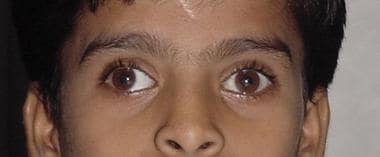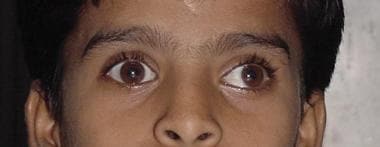Background
Exodeviation is a horizontal form of strabismus characterized by visual axes that form a divergent angle. The different types of acquired exotropia are intermittent exotropia, sensory exotropia, exotropia with neurologic causes and field defects, and consecutive exotropia. [1]
Certain conditions, such as third nerve palsy, thyroid ophthalmopathy, and iatrogenic trauma following retinal detachment surgery or endoscopic sinus surgery, could cause acquired exotropia; however, these conditions are not discussed in this article. [1]
Pathophysiology
The deviation usually begins as an exophoria. [1] Exophoria is a condition in which the alignment of the eye is straight when both eyes are open, but either eye drifts outward when covered. During this phase, the patient has bifoveal fixation. This deviation may later progress to intermittent exotropia, during which the deviation may be manifest (exotropia) or latent (exophoria).
When intermittent exotropia develops in a child whose visual system is still immature, bitemporal suppression develops, and the child does not perceive 2 separate images (diplopia). As suppression increases, intermittent exotropia may finally progress to constant exotropia. If acquired exotropia develops in adults, the patient experiences periods of diplopia during the tropic (manifest) phase. See the images below.
 Patient with intermittent exotropia at distance only. Patient is fixing with the left eye. Note the outward deviation of the right eye.
Patient with intermittent exotropia at distance only. Patient is fixing with the left eye. Note the outward deviation of the right eye.
 Patient with intermittent exotropia at distance only. Patient is now fixing with the right eye, showing that he can alternate well.
Patient with intermittent exotropia at distance only. Patient is now fixing with the right eye, showing that he can alternate well.
 Patient with intermittent exotropia at both distance and near. Patient is fixing with the left eye. Note the outward deviation of the right eye.
Patient with intermittent exotropia at both distance and near. Patient is fixing with the left eye. Note the outward deviation of the right eye.
Epidemiology
Frequency
International
Esodeviations are more frequent than exodeviations, with a ratio of 3:1.
Acquired exotropia is more common in the Middle East, Africa, and Asia and in those latitudes with higher levels of sunlight. It is less common in the United States and Europe.
Mortality/Morbidity
Diplopia and eyestrain associated with acquired exotropia can affect daily activities, such as driving and reading.
Race
No racial predilection exists.
Sex
Acquired exotropia is more common in females than in males, with a female preponderance of 63-70%.
Age
Contrary to a previous belief, intermittent exotropia can have an early onset, with 25-40% of cases occurring before the second year of life.
-
Patient with intermittent exotropia at distance only. Patient is fixing with the left eye. Note the outward deviation of the right eye.
-
Patient with intermittent exotropia at distance only. Patient is now fixing with the right eye, showing that he can alternate well.
-
Patient with intermittent exotropia at both distance and near. Patient is fixing with the left eye. Note the outward deviation of the right eye.
-
Patient with intermittent exotropia at both distance and near. Patient is now fixing with the right eye, showing that she can alternate well.
-
Kushner classification of intermittent exotropia.
-
Management options for various types of intermittent exotropia.



